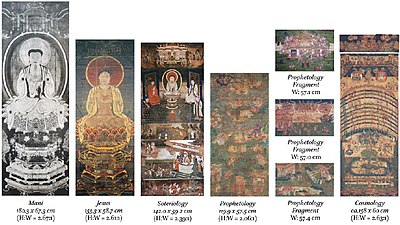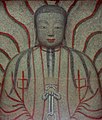Manichaean art

Manichaeism has a rich tradition of visual art, starting with Mani himself writing the Book of Pictures.[1]
One of Mani's primary beliefs was that the
On the subject of Mani's original paintings,
Illuminated manuscripts
-
MIK III 4959 both sides
-
MIK III 4974 front side, back side is just text
-
MIK III 4979 front side
-
MIK III 4979 back side
-
MIK III 6368 front side
-
MIK III 6368 back side
-
Leaf from a Manichaean book "MIK III 8259" folio 1 recto
-
Illustration from the Sogdian-language Manichaean letter found separately from the other illustrations
Manichaean
- Leaf from a Manichaean book MIK III 4959
- Leaf from a Manichaean book MIK III 4974
- Leaf from a Manichaean book MIK III 4979
- Leaf from a Manichaean book MIK III 6368
They were collected in Germany
In addition the
Silk paintings

Eight silk hanging scrolls with Manichaean didactic images from southern China from between the 12th and the 15th centuries, which can be divided into four categories:
- Two single portraits (depicting Mani and Jesus)
- One scroll depicting Salvation Theory(Soteriology)
- Four scrolls depicting Prophetology (Prophetology)
- One scroll depicting Cosmology (Cosmology)
Murals, reliefs, and banners
-
Mural depicting a tree with the vine bearing grapes, Sengim-aghiz Caves
-
Mural depicting the Tree of Life and the Tree of Death, Sengim-aghiz Caves
-
Cao'an image of Mani as the "Buddha of Light"
Manichaeism has a rich legacy of temple art including Manichaean stone reliefs of Shangwan village, Manichaean temple banner MIK III 6286, Manichaean wall painting MIK III 6918, and Veneration of the Tree of Life
Manichaean temple banner MIK III 6286 and Manichaean wall painting MIK III 6918 were both found by the German Turfan expeditions in Gaochang Xinjiang[10][11]
The Manichaean stone reliefs of Shangwan village were discovered in Fujian in 2009[13] and the origins of the Buddha of Light at Cao'an were only rediscovered in the 1920s[14]
Influence
Following the discovery of Manichaean paintings in

The Buddhist practice known as

An
In Islamic tradition (excluding
See also
Literature
- Lieu, Samuel N. C. (1992), Manichaeism in the Later Roman Empire and Medieval China, Volume 63 of Wissenschaftliche Untersuchungen Zum Neuen Testament (2 ed.), Mohr Siebeck, ISBN 3161458206
- Gulácsi, Zsuzsanna (2005). Mediaeval Manichaean Book Art: A Codicological Study of Iranian and Turkic Illuminated Book Fragments from 8th-11th Century East Central Asia. Nag Hammadi and Manichaean Studies. Vol. 57. Leiden: Brill. ISBN 978-90-474-0596-2.
- Gulácsi, Zsuzsanna (2016). Mani's Pictures: The Didactic Images of the Manichaeans from Sasanian Mesopotamia to Uygur Central Asia and Tang-Ming China. Nag Hammadi and Manichaean Studies. Vol. 90. Leiden: Brill. ISBN 978-90-04-30894-7.
References
- ^ a b Arnold, Thomas (1924). Survivals of Sasanian and Manichaean Art in Persian painting. Oxford: Clarendon Press. pp. 23–24.
- ISBN 9004064788.
- ^ doi:10.11588/ts.2011.1.6173. Retrieved December 9, 2019.)
{{cite journal}}:|volume=has extra text (help - ^ ISBN 9789004308947.
- Iranian Academy of Arts, 2023
- ISBN 9004064788.
- ISBN 978-0-87099-300-8.
- ISBN 9789004139947.
- ^ "Mani Sutra" (PDF). National Library of China (in Simplified Chinese). 2011. Retrieved 2020-05-25.
- ^ Gulacsi, Zsuzsanna. ""A Song Dynasty Manichaean Painting of the Buddha Jesus [幅宋代摩尼教<夷数佛帧> = Yifu Songdai Monijiao Yishufozheng]." Journal for the Study of Art History [艺术史研究 =Yishushi Yanjiu] 2008:139-189 [in Chinese]".
- ISBN 9789004308947.
- ^ Ma Jian (2006-11-01). "Remains of Manichaeism in Turpan". dsr.nii.ac.jp (in Simplified Chinese). Retrieved 2019-05-02.
- ^ 鍾明, ed. (2010-04-26). "《倚天屠龍記》明教遺跡藏閩霞浦小山村 (組圖)". culture.china.com.cn. Archived from the original on 2018-12-15. Retrieved 2018-12-14.
- ^ Lieu 1992, p. 304
- ISBN 0847816605.
- ISBN 900413994X.
- ISBN 900413994X.
- ^ Dr. Char Yar. "Monijiao (Manichaeism) in China". academia.edu. Lecture presented at the Worldwide Conference for Historical Research, 2012.
- Pagan Christs (2nd ed. 1911), § 14. The Problem of Manichæus, online at http://www.sacred-texts.com
- Encyclopaedia Iranica, 1999.














